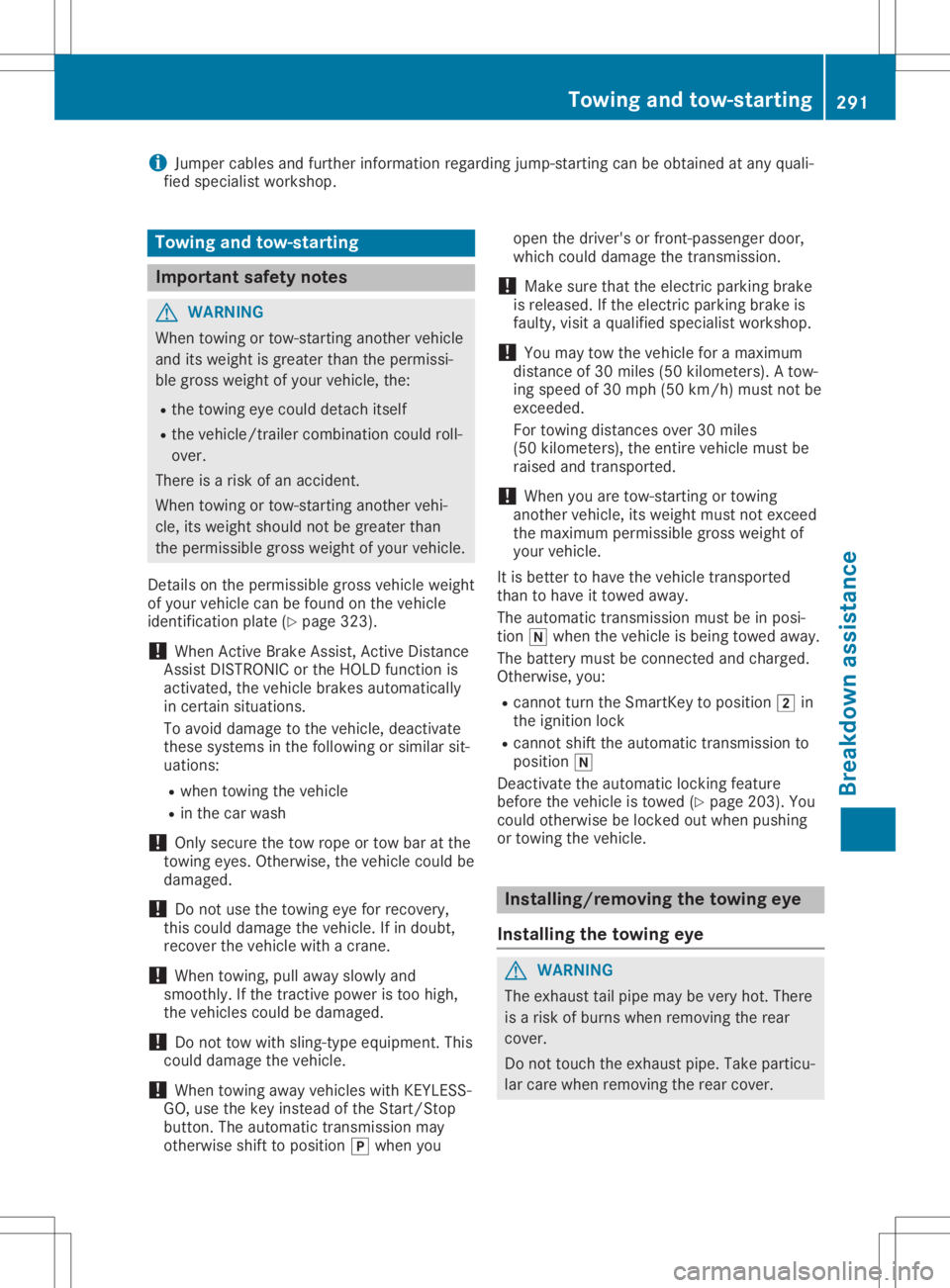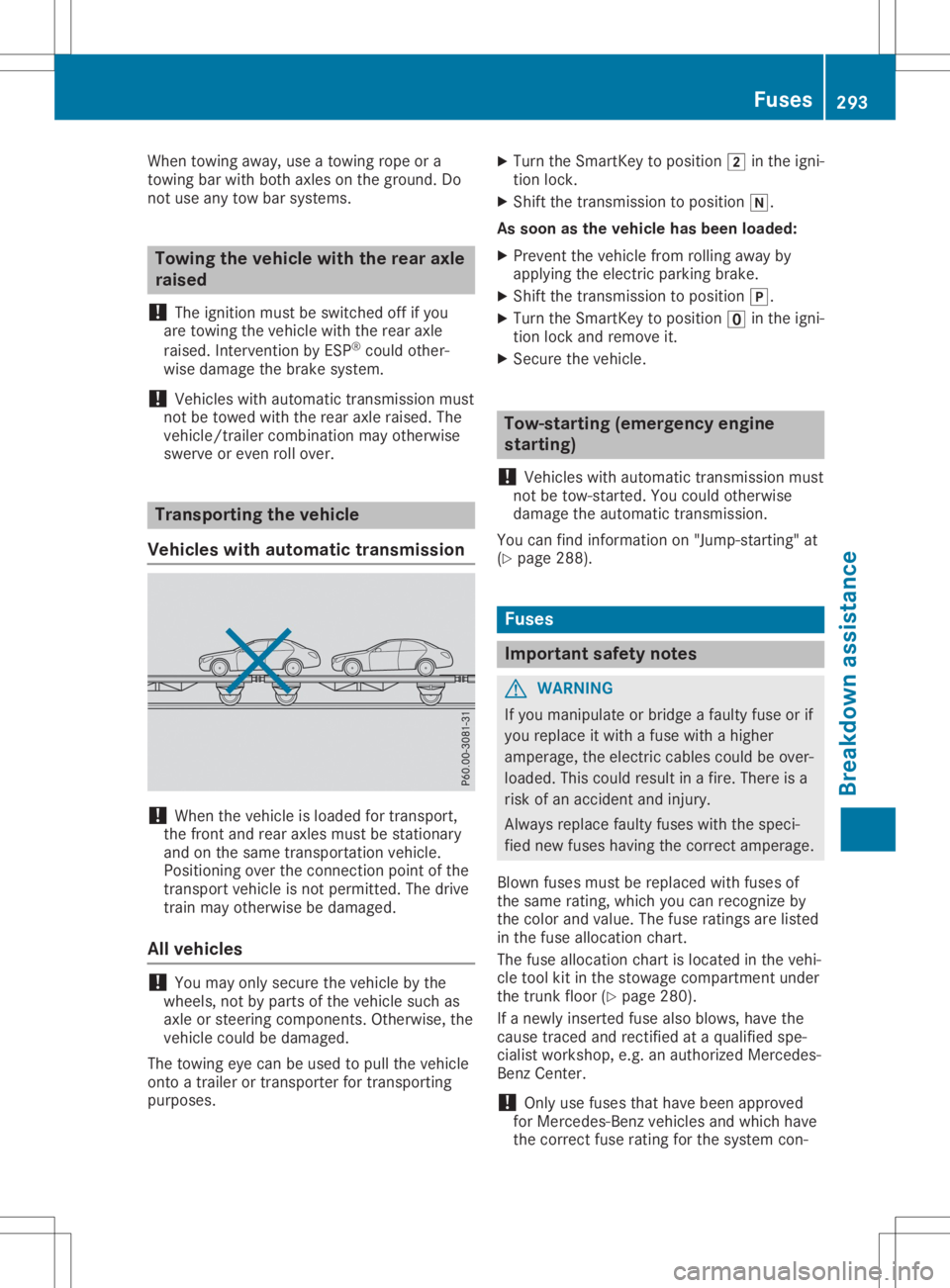jump cable MERCEDES-BENZ SL CLASS 2020 Owners Manual
[x] Cancel search | Manufacturer: MERCEDES-BENZ, Model Year: 2020, Model line: SL CLASS, Model: MERCEDES-BENZ SL CLASS 2020Pages: 334, PDF Size: 17.43 MB
Page 288 of 334

The
operating safetyofyour vehicle maybe
restr icted.
You could losecontrolofthe vehicle, for
example:
R when braking
R in the event ofabrupt steeringmaneuvers
and/or whenthevehicle's speedisnot
adapted tothe road condit ions
There isarisk ofan accident .
In the event ofashort circuit orasimilar
incident ,cont actaqualified specialist work-
shop immediately. Donot drive anyfurther.
You should haveallwork involving thebat-
tery carried outataqualified specialist
workshop.
For further informationabout ABSandESP®
,
see (Ypage 60)and (Ypage 65). G
WARNIN
G
Elect rostat icbuild-up canlead tothe crea-
tion ofsparks, whichcouldignite thehighly
explosive gasesofabattery. Thereisarisk
of an explosion.
Before handling thebattery, touchthevehi-
cle body toremove anyexistin gelectrost atic
build-up.
The highly flammable gasmixt ureforms when
charging thebattery aswell aswhen jump-
start ing.
Always makesurethatneither younorthebat-
tery iselectrost aticallycharged. Abuild-up of
electrost aticcharge canbecaused, forexam-
ple:
R by wearing clothingmade fromsynthet ic
fibers
R due tofrict ionbetween clothingand seats
R ifyou push orpull thebattery acrossthe
carpet orother synthet icmaterials
R ifyou wipe thebattery withacloth G
WARNIN
G
During thecharging process,abattery pro-
duces hydrogen gas.Ifashort circuit occurs
or sparks arecreated, thehydrogen gascan
ignite. Thereisarisk ofan explosion. R
Make surethatthepositive terminalof a
conn ected battery doesnotcome into
cont actwith vehicle parts.
R Never placemetal object sor tools ona
battery.
R Itis important thatyouobserve the
described orderofthe battery terminals
when connectin gand disconn ectingabat-
tery.
R When jump-st arting,makesurethatthe
battery poleswithidentical polarityare
conn ected.
R Itis particularly importanttoobserve the
described orderwhen connectin gand dis-
conn ectin gthe jumper cables.
R Never connectordisconn ectthe battery
termin alswhile theengine isrunnin g. G
WARNIN
G
Batt eryacid iscaustic. Thereisarisk of
injury.
Avoid contactwith skin, eyesorclothin g.Do
not inhale anybattery gases.Donot lean
over thebattery. Keepchildren awayfrom
batteries. Washawaybattery acidimmedi-
ately withplenty ofclean water andseek
medical attention. H
Environmental
note Batt
eries containpollutants.
It is illegal todispose of
them withthehousehold
rubbish. Theymust becol-
lected separately anddis-
posed ofinan environ men-
tally responsible recycling
system. Dispose
ofbatteries inan
environ mentallyresponsible
manner .Take discharged
batteries toaqualified spe-
cialist workshop ortoacol-
lection pointforused bat-
teries. 286
Bat
tery (vehicl e)Breakdown assistance
Page 291 of 334

G
WARNING
During chargingand jump-starting, explosivegase scan escap efrom thebattery .There isa
risk ofan explo sion.
Particu larlyavoi dfire, open flames,creating sparksand smoking. Ensurethereissuffi cient
ventila tionwhilechargi ngand jump-starting. Donot leanover abattery . G
WARNING
During thechargi ngprocess ,a battery produceshydrogen gas.Ifashort circuitoccurs or
spar ksare created ,the hydrogen gascan ignite. Thereisarisk ofan explo sion.
R Make surethattheposi tive terminal ofaconnected batterydoesnotcome intocontact with
vehicl eparts.
R Never placemetal objects ortools onabattery .
R Itis impor tantthatyouobse rvethe descri bedorder ofthe battery terminal swhen connect-
ing and disconnecting abattery .
R When jump-starting, makesurethatthebattery poleswith identical polarityareconnected.
R Itis particu larlyimpor tanttoobse rvethe descri bedorder whenconnecting anddisconnect-
ing the jumper cables.
R Never connect ordisconnect thebattery terminal swhi lethe engine isrunning. G
WARNING
A discha rgedbattery canfreeze attempera turesbelow freezing point.Whenjump-starting the
vehicl eor chargi ngthe battery ,gase scan escap efrom thebattery .There isarisk ofan explo -
sion.
Allow thefrozen battery tothaw outbefore chargingitor jump-starting.
! Avoid
repeatedand lengthy starting attempts. Otherwise,the catal yticconverter couldbe
dama gedbythe non-combusted fuel.
If the indica tor/warni nglamp sdo not light up atlow tempera tures,itis very likelythat thedis-
charge dbattery hasfrozen. Inthis case, youmay neither chargethebattery norjump-start the
vehicl e.The service lifeofathawe d-outbattery maybeshorter. Thestarting characteristics can
be impa ired,particu larlyat low tempera tures.Havethethawe d-outbattery checked ataqua li-
fied speci alist worksho p.
Do not start thevehicl eusi ng arapi dchargi ngdevi ce.Ifyou rvehicl e'sbattery isdischa rged,the
engine canbejump-started fromanother vehicleor from adonor battery using jumper cables.
Observe thefollowi ngpoints:
R The battery isnot accessi bleinall vehicl es.Ifthe other vehicle'sbattery isnot accessi ble,
jump-start thevehicl eusi ng adonor battery orajump-starting device.
R You may onlyjump-start thevehicl ewhen theengine andexhau stsystem arecold.
R Do not start theengine ifthe battery isfrozen. Letthe battery thawfirst.
R Only jump-start frombatterie swith a12 Vvoltag erating.
R Only usejumper cableswhi chhave asuffi cient cross-section andinsul ated terminal clamps.
R Ifthe battery isfull ydischa rged,leavethe battery thatisbei ng used tojump-start connected
for afew minutes beforeattempting tostart. Thischarge sthe battery slightly.
R Make surethatthetwo vehicl esdo not touch. Jump-star
ting
289Breakdown assistance Z
Page 292 of 334

Make
surethat:
R The jumper cablesarenot damaged.
R Bare parts ofthe terminal clampdonot come intocontactwith other metal partswhile the
jumper cablesareconn ected tothe battery.
R The jumper cablescannot comeintocontactwith parts which canmove whentheengine is
running, suchasthe V-belt pulleyor the fan.
X Secure thevehicle byapply ingthe electric parking brake.
X Shift thetransmission toposition 005D.
X Make surethattheignition isswitched off.Allindicator lampsinthe instrumen tcluster must
be off. When usingtheSmartK ey,turn theSmartK eytoposition 0092inthe ignition lockand
remove it(Y page 126).
X Switch offallelectrical consumers, e.g.rear window defroster, lighting,etc.
X Open thehood. Position
number0084identifies thecharged batteryofthe other vehicle oran equival entjump-
startin gdevice.
X Press cover0043ofpositive terminal 0044down (inthe direction ofthe arrow) andturn itclock-
wise. Toexpose positive terminal 0044,press cover 0043down further.
X Connect positiveterminal 0044onyour vehicle topositive terminal 0087ofdonor battery 0084using
the jumper cable,alwaysbegin withpositive terminal 0044onyour ownvehicle first.
X Start theengine ofthe donor vehicle andrunitat idling speed.
X Connect negative terminal0085ofdonor battery 0084toground point0083ofyour vehicle usingthe
jumper cable,beginning withdonor battery 0084first.
X Start theengine.
X Before disconnec tingthejumper cables,letthe engine runforseveral minutes.
X First, remove thejumper cablesfromground point0083and negative terminal0085,then from
positive terminal 0044and positive terminal 0087.Begin eachtimeatthe cont acts onyour own
vehicle first.
X Aft erthe jumper cableisremoved, returncover0043ofpositive terminal 0044tothe original posi-
tion. Positive terminal 0044iscovered upand thus insulated again.
X Have thebattery checkedataqual ified specialist workshop.
Jump-starting isnot considered tobe anormal operating condition. 290
Jump
-startingBr eakdown assistance
Page 293 of 334

i
Jumper
cablesand further inform ationregar dingjum p-startingcan beobt aine dat any quali-
fied spec ialist workshop. Towing
andtow- star tin g Imp
ortant safety notes G
WAR
NING
When towing ortow-s tartingano ther veh icle
and itsweight isgreat erthan theperm issi-
ble grossweight ofyour vehicle,th e:
R theto wing eyecould detach itself
R theveh icle/trailer combinatio ncould roll-
over .
Ther eis arisk ofan acc iden t.
When towing ortow-s tartingano ther veh i-
cle, itsweight shouldno tbe great erthan
th eperm issiblegro ssweight ofyour vehicle.
Det ails ontheperm issiblegro ssveh icle weight
of your vehicle can befoun don theveh icle
iden tificat ion plat e(Y page 323).
! When
ActiveBr ake Assist ,Ac tiveDis tan ce
As sist DISTRO NICortheHOL Dfun ction is
act ivat ed, theveh icle brak esauto matically
in cer tain situatio ns.
To avoid damage totheveh icle,deac tivate
th ese systems inthefollo wing orsimi larsit-
uatio ns:
R when towing theveh icle
R in thecar wash
! On
lysec ure theto w rope ortow bar atthe
to wing eyes. Other wise, theveh icle could be
damage d.
! Do
notuse theto wing eyeforrecover y,
th is could damage theveh icle.If in doubt ,
rec over theveh icle with acr ane.
! When
towing ,pull away slowly and
smo othly. Ifth etract ive power istoohigh ,
th eveh iclescould bedamage d.
! Do
notto w with sling-type equipm ent.This
could damage theveh icle.
! When
towing away vehicleswith KEYLE SS-
GO, usethekey instead oftheSt art /S top
butt on.The auto matictrans miss ionmay
ot her wise shiftto posit ion005Dwhen you open
thedriv er'sor fron t-passe nger door ,
whic hcoul ddamage thetrans miss ion.
! Mak
esure that theelec tric park ingbrak e
is rele ased. Ifth eelec tric park ingbrak eis
fault y,visi ta qualifie dspec ialist workshop.
! You
may tow theveh icle foramax imum
dist anceof 30 miles (50kilomet ers). Ato w-
ing speed of30 mph (50km/h) must notbe
exc eeded .
For towing distancesover 30miles
(50 kilomet ers), theent ireveh icle must be
raise dand trans port ed.
! When
youaretow-s tartingor towing
ano ther veh icle,its weight mustnotexc eed
th emax imum permissiblegro ssweight of
your vehicle.
It is bet terto have theveh icle trans port ed
th an tohave itto wed away.
The auto matictrans miss ionmust beinposi-
tio n005C when theveh icle isbein gto wed away.
The batterymust becon nectedand char ged.
Ot her wise, you:
R can nottur nth eSm artKey toposit ion0048in
th eign itio nloc k
R can notshif tth eauto matictrans miss ionto
posit ion005C
De act ivat eth eauto maticloc kin gfeat ure
befo retheveh icle istowed (Ypage 203). You
coul dot her wise belocked outwhen pushin g
or towing theveh icle. Inst
allin g/rem ovingthetowing eye
Inst allin gth etowing eye G
WAR
NING
The exhaust tailpipe maybeveryhot .Ther e
is arisk ofburn swhen removin gth erear
cov er.
Do notto uch theexh aust pipe. Takepart icu-
lar carewhen removin gth erear cover. Towing
andtow- star tin g
291Break down assistance Z
Page 295 of 334

When
towing away,useatowing ropeora
towing barwith both axles onthe ground. Do
not use anytow barsystems. Towing
thevehicle withtherear axle
raised
! The
ignition mustbeswitched offifyou
are towing thevehicle withtherear axle
raised. Interven tionbyESP®
could other-
wise damage thebrake system.
! Vehicles
withautomatic transmission must
not betowed withtherear axle raised. The
vehicle/t railercombin ationmayotherwise
swerve oreven rollover. Tr
anspor tingthevehicle
Vehicles withautomat ictransmission !
When
thevehicle isloaded fortran sport,
the fron tand rear axles mustbestation ary
and onthe same transportat ionvehicle.
Position ingover theconn ection pointofthe
tran sport vehicle isnot permitt ed.The drive
train mayotherwise bedamaged.
All vehicles !
You
may onlysecure thevehicle bythe
wheels, notbyparts ofthe vehicle suchas
axle orsteerin gcompon ents.Other wise, the
vehicle couldbedamaged.
The towing eyecan beused topull thevehicle
ont oatrailer ortran sporter fortran sportin g
purposes. X
Turn theSmart Keytoposition 0048inthe igni-
tion lock.
X Shift thetran smission toposition 005C.
As soon asthe vehicle hasbeen loaded:
X Preven tthe vehicle fromrolling awayby
applying theelectr icparking brake.
X Shift thetran smission toposition 005D.
X Turn theSmart Keytoposition 0092inthe igni-
tion lock andremove it.
X Secure thevehicle. Tow-sta
rting (emergency engine
star ting)
! Vehicles
withautomatic transmission must
not betow-s tarted. You could otherwise
damage theautomatic transmission.
You canfind inform ationon"Jump-start ing"at
(Y page 288). Fuses
Impor
tantsafety notes G
WARNIN
G
If you manipulate orbridge afaulty fuseorif
you replace itwith afuse withahigher
amperage, theelectr iccables couldbeover-
loaded. Thiscould result inafire. There isa
risk ofan accident andinjury.
Always replace faultyfuseswiththespeci-
fied new fuses having thecorr ectamperage.
Blown fusesmustbereplaced withfuses of
the same rating,which youcan recogn izeby
the color andvalue. Thefuse rating sare listed
in the fuse allocation chart.
The fuse allocation chartislocated inthe vehi-
cle tool kitinthe stowage compartmentunder
the trun kfloor (Ypage 280).
If anewly insertedfuse alsoblows, havethe
cause tracedand rectified ataqualified spe-
cialist workshop, e.g.anauthorized Mercedes-
Benz Center .
! Only
usefuses thathave been approved
for Mercedes- Benzvehicles andwhich have
the corr ectfuse rating forthe system con- Fuses
293Breakdown assistance Z